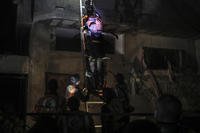The U.S. Defense Department has significantly scaled back its criticism against Lockheed Martin Corp. over development of the F-35 Joint Strike Fighter, the Pentagon's most expensive weapons acquisitions program.
Air Force Lt. Gen. Christopher Bogdan, the general overseeing the effort, said the relationship between the service and Lockheed -- the plane's manufacturer and the world's biggest defense contractor -- along with engine-maker Pratt & Whitney, part of United Technologies Corp., is "orders of magnitude" better than it was a year ago.
"I'm encouraged by where we are today," he said Tuesday at the Air Force Association's Air & Space Conference and Technology Exposition at National Harbor, Md. "I'd like to be a little further along."
The comments were a stark contrast to those Bogdan made at the same forum last year, when he called the relationship the "worst I've ever seen." On Tuesday, Bogdan indicated his previous remarks were deliberate. "I threw a hand grenade into the crowd ... that was intended," he said.
Over the past year, the service and the Bethesda, Md.-based defense contractor have successfully negotiated contracts for two batches of aircraft known as Lots 6 and Lots 7, Bogdan said. Moreover, the terms of the agreements stipulate that Lockheed will have to pay for any cost overruns, he said.
Still, Bogdan didn't rule out that the military may have to reduce the number of aircraft it ultimately intends to buy because of automatic budget cuts known as sequestration.
The estimated price tag to develop and build 2,457 F-35 Lightning II fighter jets includes $326.9 billion for air frames and $64.3 billion for engines, according to Pentagon figures released earlier this year. The combined amount is $4.5 billion, or 1.1 percent, less than an estimate of $395.7 billion released in March 2012. The decline was attributed in part to revised labor rates charged by the prime contractor and its subcontractors.
The Defense Department in fiscal 2014, which begins Oct. 1, plans to spend $8.4 billion to buy 29 F-35 Lightning IIs, including 19 for the Air Force, six for the Marine Corps and four for the Navy, according to the budget request released last month. The plane is designed to replace such aircraft as the F-16, A-10, F/A-18 and AV-8B.
Across-the-board budget reductions may force the military to decrease the quantity of aircraft it plans to purchase, Bogdan said. Even so, the plane more affordable is still the program's priority, he said.
“We can have the best airplane in the world, but if no one can afford it, then it does us no good," he said.
Bogdan said he is confident the Marine Corps will be able to begin operational flights of its version of the F-35 in 2015, followed by the Air Force in 2016 and the Navy in 2019. Test pilot Lt. Col. C.R. "Jimi" Clift on Aug. 14 completed the first ever vertical night landing aboard the USS Wasp at Naval Air Station Patuxent River in Maryland.
Software problems are still the biggest risk for the program, Bogdan said. Lockheed this summer said it boosted its software workforce by 200 engineers and invested $100 million to build a second laboratory to write, test and verify the code.









